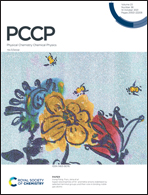Mechanical ductile detwinning in CH3NH3PbI3 perovskite
Abstract
Twin boundaries (TBs) were identified to show conflicting positive/negative effects on the physical properties of CH3NH3PbI3 perovskites, but their effects on the mechanical properties are still unclear. Herein, the tensile characteristics of a variety of TB-dominated bicrystalline CH3NH3PbI3 perovskites are explored using molecular simulations. The results show that TB-containing CH3NH3PbI3 perovskites can be classified into four types based on their tensile ductile detwinning characteristics. Type I is characterized by smooth loading flow stress–strain responses, originating from relatively uniform stress distribution induced gradual amorphization in the TB region. Types II and III are represented by a sudden drop in loading stresses but then distinct ductile flow stress–strain curves, resulting from limited and large-area amorphizations of TB-involved structures, respectively. However, Type IV is highlighted by double apparent peaks in the loading curve, followed by a ductile flow response, originating from the stress-concentration of localization-to-globalization in the TB region, as well as amorphization. This study provides critical insights into the mechanical characteristics of CH3NH3PbI3 perovskites and indicates that TB engineering is a promising strategy to design mechanically robust hybrid organic–inorganic perovskite-based device systems.



 Please wait while we load your content...
Please wait while we load your content...